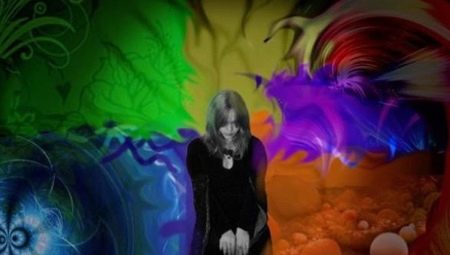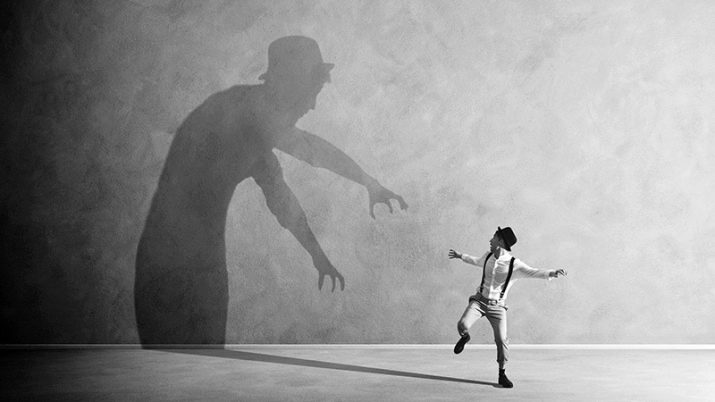Color perception is an important ability to obtain information about the world. Thanks to the ability to distinguish colors, we can identify many objects and their special characteristics, and also usually each person has his own favorite and unloved colors and shades. But there are people who painfully perceive a particular color or several colors. They cause them panic irrational fear, which is called chromatophobia.
Description
Chromatophobia - it is the strongest irrational fear on the verge of disgust for color. In most cases, an inadequate attitude is observed towards a particular color - a person is afraid only of red, black or yellow. Less commonly, fear causes a combination of colors or a wide range of palettes.
Uncontrolled fear of each particular color is called its own way, for example, the fear of red is fodophobia, and the fear of blue is cyanophobia, the fear of yellow is xanthophobia, and the fear of green is prasinophobia. Pathological fear of white color is called leukophobia, orange color is chrysophobia, black color is melanophobia.
Almost always chromatophobe afraid of bright colors.
Pastel colors of frightening color can cause anxiety, but rarely - panic, but a bright and saturated unpleasant color can cause a panic attack, loss of consciousness, confusion.
All individual types of chromatophobia are closely associated with psycho-traumatic events that were subconsciously associated with a particular color gamut. It is noteworthy that Some types of animals, as well as people who are color blind, may suffer from chromatophobia.
This phobia, although it occurs less frequently, can make life difficult. To avoid the likelihood of suddenly encountering a frightening color, a person can limit his social circle, go outside, refuse to attend work just because the unpleasant color in the office or company uniform does not allow the person to concentrate and perform his professional tasks.
People with chromatophobia try to avoid large cities with an abundance of signs and screens, with assorted and colorful crowds, and transport. There is evidence that Benjamin Franklin did not like the yellow objects, and Billy Bob Thornton suffers from chromatophobia in several shades of the palette at once.
The reasons
Intolerance of a tone or shade usually develops after childhood psychotrauma. Such injuries for an impressionable, suspicious child with a vulnerable psyche and great imagination can be the death of a loved one, separation from parents, cruel treatment, violence, accidents. For example, at a funeral on the occasion of the death of a loved one, the child sees an abundance of black, and this color can be deposited in the subconscious, as it is closely associated with death, loss, loss.
A child who has been abused may not remember the faces of the abuser and the abuser, but may well remember the color of his clothes. And this shade can be frightening for all your life, unpleasant, causing a real panic.
Sometimes the cause of chromatophobia lies in the cultural traditions of the people. In each culture, shades and tones give their meaning. In India, China and Japan, most often they are afraid of exactly white color, since there it symbolizes unhappiness, death. Red color often causes hostility among Europeans, as it is associated with impurity, sin, blood, aggression.
Blue, which for many nations symbolizes heaven and the divine principle, for the Iranian is the color of mourning and grief. Black, which for most people is anxious in itself, is revered in India, where it is considered the color of health and harmony.
Rejection of a certain color, up to an irrational panic fear of him, can arise in a particular person in connection with his personal associations.
So, green for one is associated with young spring greens, and for another with unpleasant and dangerous mold, yellow for some is the color of wealth, luck, sun and warmth, good mood, and for some it is the color of pus, the unhealthy yellowness of the dying skin. person therefore everything is quite individual. How many chromatophobes, so many justifications, reasons for their fear.
Symptoms and signs
Chromatophobe is constantly tense - a collision with an unpleasant tinge can occur at any time. There are never shades in his clothes that even remotely resemble a frightening tone, there are no objects in his house that are painted in such a color. Chromatophobes tend to think carefully about their actions, the places that they should visit, the routes that they will have to get to these places. If there are frightening objects along the way, a chromatophob can make a big detour, get with a few detour transplants, just not to face what causes anxiety and horror.
If it suddenly happens that the collision could not be prevented, A person suffering from this phobia will release adrenaline into the blood. Under the action of this hormone, the pupils dilate, there is a desire to run away and hide from danger, while the person understands all the absurdity of his condition, is afraid that others will notice this, and this second joined fear only intensifies the manifestations. Heartbeat becomes more frequent, shallow breathing is shallow. The skin turns pale, sweat profusely stands out, slightly reduced body temperature.
It dries out in the mouth, a tremor of the limbs may appear. In severe cases, a person loses his balance, loses consciousness.
Treatment
Calls to pull themselves together and an effort of will to overcome fear in the case of chromatophobia can be not only meaningless, but also harmful. Fruitless attempts to do this cause only a decrease in self-esteem. To cope with phobic mental disorders on their own is impossible. You can drive the fear even deeper, then it will manifest itself with double force and will “overgrow” with additional mental disorders.
Therefore, the most correct is to appeal to a specialist - a psychotherapist or psychiatrist (psychologists do not deal with the treatment of phobias).
To get rid of the irrational fear the doctor can use one of the many methods of psychotherapy or several methods cumulatively - cognitive-behavioral therapy, rational therapy, gestalt therapy, hypnotherapy, NLP. Sometimes there is a need for additional prescription medication. Antidepressants can be used that significantly increase mood.
Tranquilizers try to prescribe only in rare cases when panic attacks are frequent, severe, associated with inappropriate behavior.. It will be useful relaxation training, including deep muscular, this helps to achieve yoga, meditation, mastering the techniques of breathing exercises.
During the entire course of treatment (and it usually lasts several months), the patient is required to comply with all the recommendations of the doctor, work with him on the same team: you should exclude strong stresses, feelings, alcohol, drugs. It is important to enlist the support of loved ones and relatives, friends, all who the patient trusts.
It is desirable that with the start of therapy in walks around the city and visiting art galleries (as a method of immersion in a variety of colors), it is close people who accompanied the person, insuring him in case of a possible panic attack. In general, the forecasts are very favorable.In 9 out of 10 patients with psychotherapy, it is possible to achieve persistent long-term remission.
The probability of relapse will be minimal if yesterday's patient leads a rich life, learns to focus not only on himself and within himself, but on an interesting hobby, communication, other people.
See the video below for interesting facts on chromatophobia.


















